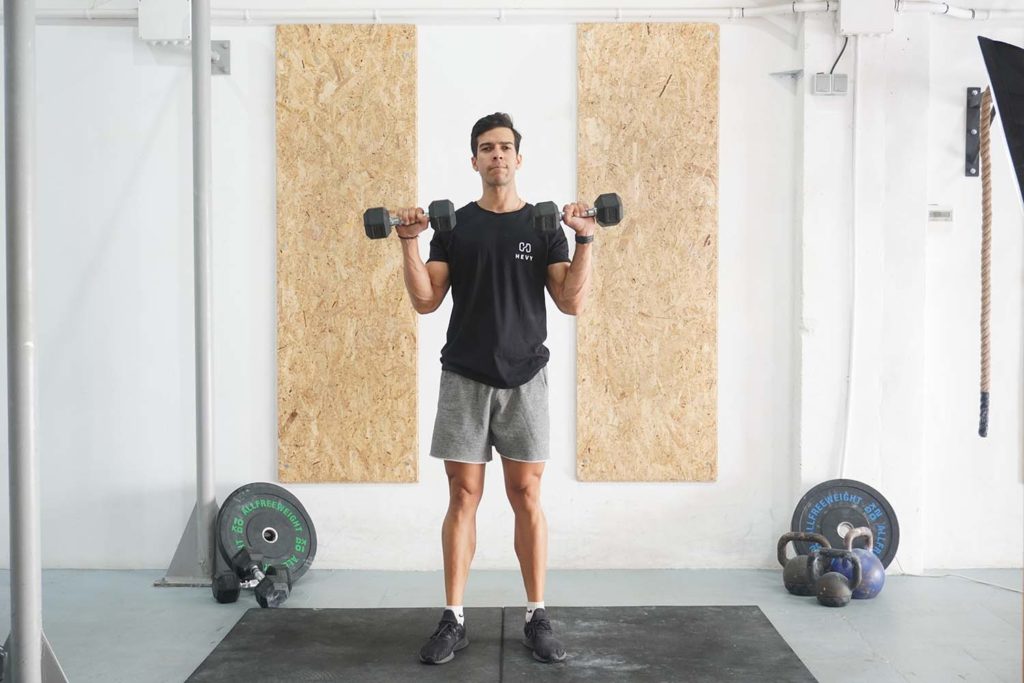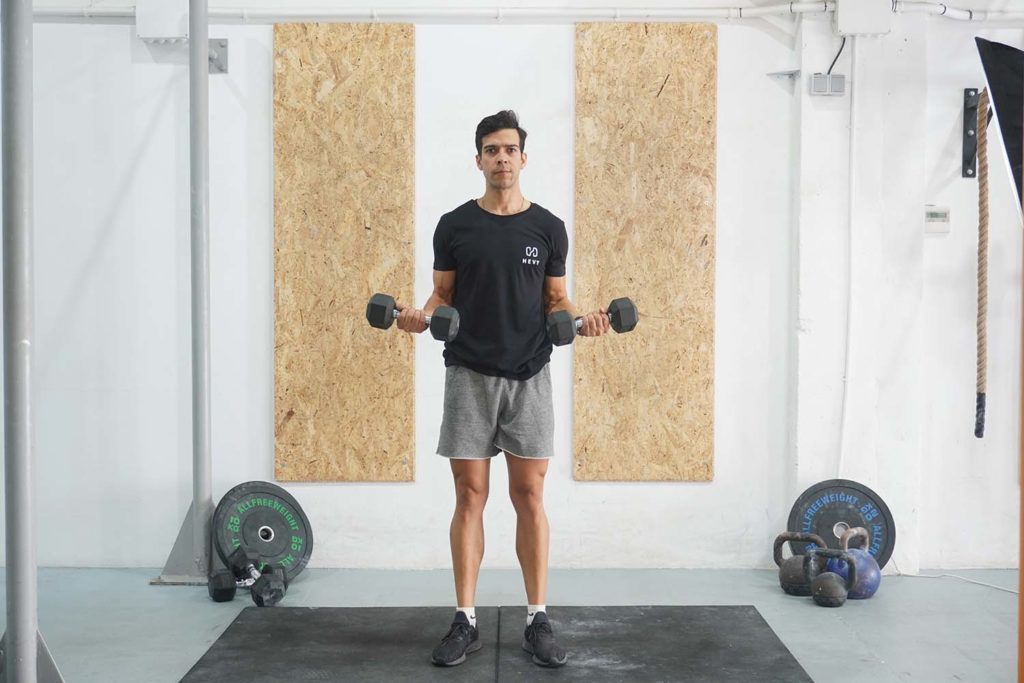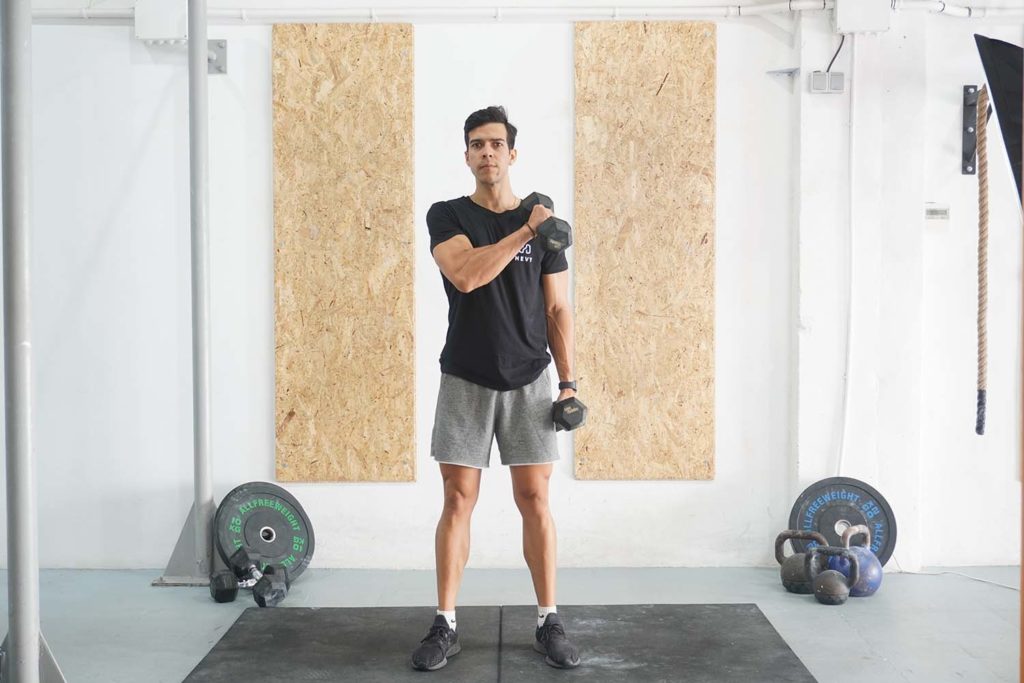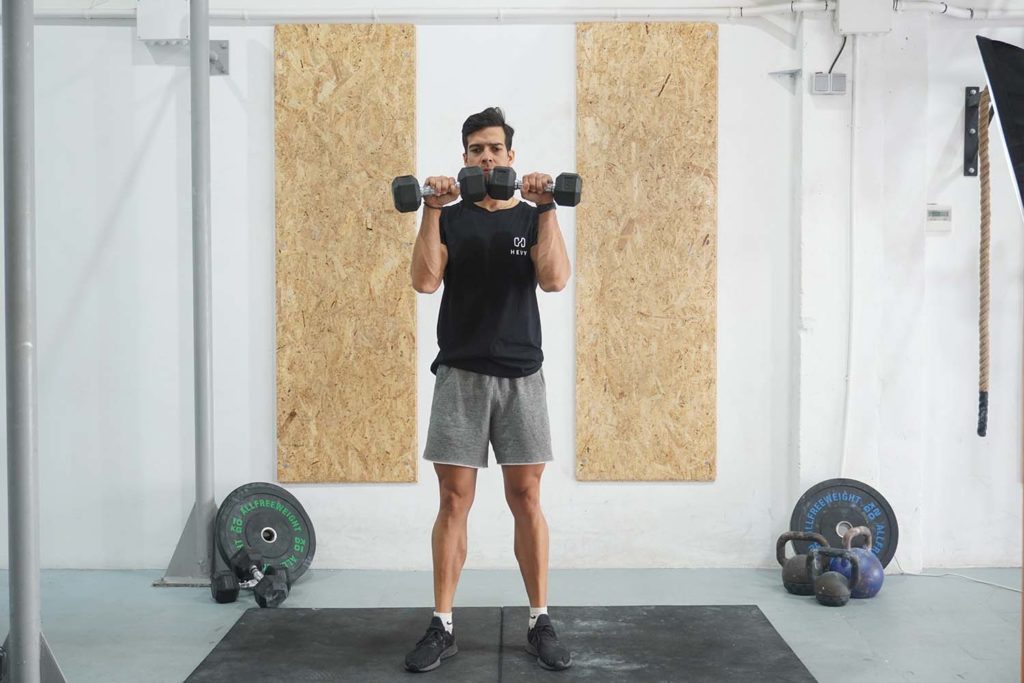What are the benefits of the zottman curl?
Developed by George Zottman in the 19th century, the Zottman curl is a bicep exercise with unique benefits. Unlike traditional curls, where you maintain a consistent wrist position, Zottman curls combine two exercises.
The Zottman curl trains our biceps and forearms well because it forces us to use an overhand and underhand grip on every repetition. We begin the movement by doing a traditional bicep curl. We then have to rotate our wrists 180 degrees for the second half of each repetition. Doing so achieves three things:
- We emphasize the biceps and brachioradialis well on every repetition.
- The rotational element of each repetition further engages our forearms and biceps.
- Alternating between two wrist positions forces us to use the appropriate weight and emphasize good technique.
Adding the Zottman curl to your arsenal of movements is a great way to improve your form, spark new muscle growth, and work your forearms.
How to do a Zottman Curl
- Grab a pair of light dumbbells and stand tall with your shoulders back, gaze forward, arms to your sides, and palms facing forward. Have your feet hip-width apart with toes pointed slightly out.
- Take a breath and curl both dumbbells up as you keep your elbows in a stationary plane.
- As you near the top of the curl, twist both wrists inward nearly 180 degrees to position your palms toward the floor.
- As your palms face down, exhale and slowly lower both dumbbells to the starting position until your elbows are straight.
- At the bottom, twist both wrists out to their initial position. Take another breath and curl again.
What muscles do the zottman curl activate?
Zottman curls primarily train our biceps, which produce elbow flexion and are influenced by wrist position (1). Our biceps are mainly active at the start of each repetition because that part is a traditional curl. We then rotate our wrists, shifting the emphasis away from the biceps and onto the forearms. Our biceps are put at a mechanical disadvantage thanks to wrist position, but they still contribute as we lower the dumbbells.
Zottman curls also engage the brachioradialis, which is a large and superficial forearm muscle (2). Once we reach the top of the curl, rotating our wrists puts the brachioradialis at a mechanical advantage, allowing it to control the weight on the way down.
Zottman curls are also great for the brachialis because the muscle group assists the bicep with elbow flexion (3). The brachialis becomes more active when we point our palms down because our biceps can no longer produce much force. So, we must rely on the brachialis and brachioradialis to make up for the bicep, allowing us to finish each repetition.
Traditional Bicep Curl Vs. Zottman Curl
Traditional curls are a fantastic bicep exercise because we never put the muscle group at a mechanical disadvantage. As a result, our biceps produce the majority of the force we need to complete each repetition. For example, as you initiate a traditional curl, your biceps produce a lot of force to create elbow flexion. The biceps continue to work at the top position and control the weight on the way down.
In contrast, Zottman curls provide greater variety and allow us to train more muscles simultaneously. Instead of keeping the bicep in charge the whole time, Zottman curls offer a fair approach. The biceps work, but they also allow our forearms and brachialis to do some of the work.

Both types of exercises are similar, but Zottman curls don’t get as much attention these days. Instead, many trainees prefer to go down the traditional route and focus on the bicep, which isn’t necessarily bad. Bicep curls are fantastic for growth, so long as you do them right. But Zottman curls also carry value because the movement reinforces good technique and allows us to train our biceps and forearms in a balanced way.
Variations of Exercise
1. Zottman Curls With a Resistance Band
You can do Zottman curls with a resistance band for peak tension at the top. Take an open-ended resistance band and step over it. Your stance width will depend on the band and how much you need to shorten it to feel adequate resistance. Once you’ve set up, do Zottman curls as you would with a pair of dumbbells.
2. Reverse Zottman Curl
The reverse Zottman curl is a variation where you begin each repetition with palms facing down. You then rotate your wrists at the top and finish the repetition with a traditional bicep curl grip.
3. Seated Zottman Curl
The seated Zottman curl is a useful variation for taking your body out of the equation. As a result, your arms have to do all the work, and you eliminate the risk of momentum. Sit down on a gym bench and proceed to do Zottman curls as you would from a standing position.
Mistakes to Avoid
The most common Zottman curl mistake is using heavy dumbbells. Many trainees start learning the Zottman curl by using the same dumbbells they use on traditional curls. The problem is that Zottman curls are much more technical, and using too much weight will prevent you from doing them right. Start with a pair of light dumbbells to learn the movement and gradually increase the weight as you get comfortable.
Another mistake to avoid with the Zottman curl is moving your elbows back and forth. Resist the urge to move your elbows forward as you lift the dumbbells. Moving your elbows can make the rotation and subsequent lowering easier, but it will remove the tension from your arm muscles. Instead, keep your elbows locked in at your sides, no matter how difficult the repetitions get.
The third major mistake to avoid is rushing the movement. Some trainees would pick the dumbbells, curl them, and rotate their wrists quickly before dropping the weights. But genuinely effective Zottman curls are slow and graceful. You have to do each part of the repetition slowly, making sure to engage the correct muscles. Don’t be afraid to take your time with each repetition because doing so will make the exercise effective.
Similar Exercises to the Zottman Dumbbell Curl
Bicep Curl (Dumbbell)

The bicep curl is similar to Zottman curls because it represents the first half of each repetition. When doing a Zottman curl, you initiate each repetition with your palms facing up before rotating them to finish with a reverse curl. Similarly, you start a bicep curl with palms facing up but don’t turn your wrists for the second portion of the repetition. Zottman and classic dumbbell curls work well together because they lead to more balanced arm development.
Pinwheel Curl

Pinwheel curls, also known as cross-body curls, are movements where you lift the dumbbell in front of your chest. Your wrists are in a neutral position, which allows your biceps and brachioradialis to contribute more evenly. As a result, pinwheel curls offer similar arm development to Zottman curls.
Reverse Curl (Dumbbell)

The reverse dumbbell curl is a movement where you lift the weights with your palms facing down. Doing so is good for putting your bicep at a mechanical disadvantage and forcing your forearm muscles to do more work. Reverse curls are similar to Zottman curls because the movement represents the second half of each repetition. As you curl the dumbbell and rotate your wrists, you finish the repetition by doing a reverse dumbbell curl.
